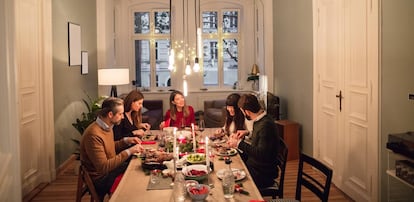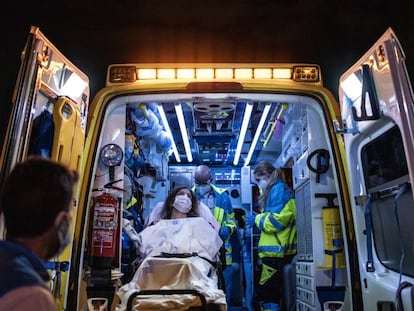What Christmas in Catalonia will look like under coronavirus restrictions
The regional government’s plan for a gradual reopening of activities preserves strict limits on social gatherings and travel during the holiday season

Christmas in Catalonia this year will most likely involve smaller family gatherings and no late-night New Year street partying.
Procicat, the Catalan government agency coordinating action against the pandemic, will on Wednesday debate how and when to lift restrictions that were introduced to fight a second wave of the coronavirus pandemic.
The four-phase plan is due to go into effect on Monday and conclude on January 18. Each phase is expected to last 15 days, on the condition that the number of hospitalized Covid-19 patients gradually declines. If not, the rules will remain in place until figures improve.

The Catalan government admits that the northeastern region is in the grip of a second wave of coronavirus, and expects that the situation at Christmas will force authorities to limit social gatherings to no more than 10 people. The executive also expects to have a curfew in place on New Year’s Eve, and to keep the regional borders sealed until January 18.
But Catalan authorities are refusing to call it a deescalation plan. Instead, government spokesperson Meritxell Budó has insisted that the health department’s recommendations are a plan for a progressive reopening, if epidemiological figures allow it. Budó refused to “advance scenarios,” but the Plan for a Gradual Reopening of Activities suggests that the 10pm curfew and the regional border closure will remain in place for some time.
Some things will not change over the next two months. Conventions and fairs will continue to be banned. Nightlife venues, indoor children’s play spaces, bingo halls, casinos and gaming parlors will remain closed. In-person schooling will be very limited. Bars and restaurants will continue to be subject to strict restrictions.
These latter restrictions have come up against significant opposition from the food and drink industry, and highlighted internal divisions within the governing coalition. On Tuesday, industry leaders joined the Catalan chief of Enterprise and Knowledge Ramon Tremosa in a public event to reveal a negotiated deescalation plan.
On the same day, the Catalan health department released its own proposals for reduced capacity and opening hours at bars and restaurants. This triggered indignation among industry leaders, who said that the Catalan government is not one but two: the government of Together for Catalonia (JxCat) which listens to the sector, and the government of the Catalan Republican Left (ERC), which ignores entrepreneurs. “We don’t like to be governed by someone who is 600 kilometers away,” said Joan Canadell, president of the Barcelona Chamber, alluding to the central government in Madrid. “But we also don’t like to have a government that is not close to the people.”
The following are some of the most relevant measures contemplated for each phase, as long as coronavirus figures allow it.
Phase 1: November 23 to December 7
Mobility will be somewhat expanded on weekends. It will be possible to travel across one’s comarca – an administrative division smaller than a province – from 6am on Friday to 6am on Monday. Starting on Monday, bars and restaurants may open from 6am to 5pm, with a 30% capacity limit on outdoor seating areas and the same in indoor spaces as long as these have good natural or artificial ventilation.
Attendance at museums and exhibition spaces will be raised from 33% to 50% of capacity. Cinemas, theaters, auditoriums and concert halls with seating for 600 or under may open at 50% of capacity. Small retail stores may open 30% of their surface area to clients.
University students will continue to follow online classes, while post-secondary Bachillerato students will see their in-person activities significantly reduced. Outdoor sports facilities will open at 50% of capacity. Religious and civil ceremonies may be held at 30% of capacity with an upper limit of 100 people.
Phase 2: December 8 to 21
Social gatherings are still restricted to six people. If coronavirus figures allow it, bars and restaurants may open at 50% of capacity, both indoors and outdoors, although closing time will still be 5pm. Attendance at museums and retail stores will be capped at 50% of capacity, and 70% in cinemas, theaters and auditoriums.
Phase 3: December 22 to January 4
Gatherings of up to 10 people from two family “bubbles” will be allowed. This effectively prohibits large extended family gatherings and Christmas company dinners. Attendance at bars and restaurants will still be capped at 50% of capacity, but closing time will be pushed to 9pm. Religious ceremonies may be held at 30% of capacity. This figure will be 30% for large shopping spaces, 50% for small stores, and 70% for museums, cinemas, theaters and concert halls. The maximum attendance at outdoor sports facilities is set at 70%.
Phase 4: January 5 to January 19
Social gatherings are still limited to a maximum of 10 people. Bars and restaurants may open at 50% of capacity until 9pm, and the same cap is applied to retail stores of any size. In this phase, the Catalan government might allow sports competitions to resume, and let students in Bachillerato education go back to in-person classes. Conventions and fairs will still be banned.
English version by Susana Urra.
Tu suscripción se está usando en otro dispositivo
¿Quieres añadir otro usuario a tu suscripción?
Si continúas leyendo en este dispositivo, no se podrá leer en el otro.
FlechaTu suscripción se está usando en otro dispositivo y solo puedes acceder a EL PAÍS desde un dispositivo a la vez.
Si quieres compartir tu cuenta, cambia tu suscripción a la modalidad Premium, así podrás añadir otro usuario. Cada uno accederá con su propia cuenta de email, lo que os permitirá personalizar vuestra experiencia en EL PAÍS.
¿Tienes una suscripción de empresa? Accede aquí para contratar más cuentas.
En el caso de no saber quién está usando tu cuenta, te recomendamos cambiar tu contraseña aquí.
Si decides continuar compartiendo tu cuenta, este mensaje se mostrará en tu dispositivo y en el de la otra persona que está usando tu cuenta de forma indefinida, afectando a tu experiencia de lectura. Puedes consultar aquí los términos y condiciones de la suscripción digital.
More information
Últimas noticias
Most viewed
- Reinhard Genzel, Nobel laureate in physics: ‘One-minute videos will never give you the truth’
- Oona Chaplin: ‘I told James Cameron that I was living in a treehouse and starting a permaculture project with a friend’
- Pablo Escobar’s hippos: A serious environmental problem, 40 years on
- Why we lost the habit of sleeping in two segments and how that changed our sense of time
- Chevy Chase, the beloved comedian who was a monster off camera: ‘Not everyone hated him, just the people who’ve worked with him’










































